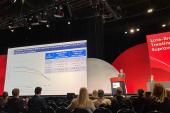One-Third of Patients With AF After Surgery or Illness Have Recurrences
Close follow-up “when the dust settles” after an acute stressor is needed to identify patients with true AF, says William McIntyre.

Roughly one-third of patients who develop new-onset atrial fibrillation (AF) while hospitalized for noncardiac surgery or a medical illness will have recurrent AF within the year, according to the results of a new study.
The new findings, say investigators, emphasize the importance of checking up on patients who develop in-hospital AF to determine a course of action.
“The takeaway here is to follow your patients,” lead investigator William McIntyre, MD, PhD (McMaster University/Population Health Research Institute, Hamilton, Canada), told TCTMD. “You can’t dismiss what you’ve seen in the hospital, nor can you be confident that they have [paroxysmal AF], which has an important diagnostic label, and then go into a pathway of evidence-based treatment. You need to reassess these patients when the dust settles, so to speak.”
Transient, new-onset AF can occur in response to physiologic stress, such as a hospitalization for medical illness or surgery, but the incidence ranges broadly depending on the patient population, reason for hospitalization, and how closely doctors are looking for it. “Of course, when you think about all-comers in the hospital, from infections like pneumonia on a general internal medicine ward to all the overnight surgeries, you’re talking millions of patients around the world,” said McIntyre. “We’ve got a super common problem on our hands.”
The American Heart Association published a scientific statement earlier this year warning that AF detected during hospitalization for another condition can be associated with a high rate of recurrence and requires appropriate clinical attention. As the authors summarize in the current paper, data published to date suggest AF can recur in nearly half of patients discharged after hospitalization for sepsis, with a similar recurrence rate seen in a heterogenous group of medical and surgical patients in the Framingham Heart Study. Other studies have shown that AF recurred in 37% of patients after noncardiac surgeries.
It’s hard to make that judgement about the long-term significance then and there in the acute setting. William McIntyre
The new study, which is an analysis of the Atrial Fibrillation Occurring Transiently with Stress (AFOTS) study published October 2, 2023, in the Annals of Internal Medicine, included patients admitted to ICUs, surgical wards, and medical wards for noncardiac reasons who had no history of AF prior to admission but had AF detected during their hospitalization. Upon discharge, the identified patients wore a continuous ECG patch monitor (iRhythm Technologies) for 14 days at 1 and 6 months and were followed for 1 year. Patients with transient, new-onset AF were matched with age- and sex-matched controls who were hospitalized but did not develop AF during their stay.
For the 139 patients who developed AF in the hospital, the median duration of the longest episode was 15.8 hours and 23.7% had symptoms. AF converted spontaneously in 70% of those with episodes.
At 1-year follow-up, AF was detected in 33.1% of patients with transient, new-onset AF during hospitalization and in 5.0% of the control group. After adjusting for the number of ECG measurements and baseline clinical characteristics, patients with transient AF had a more than sixfold higher relative risk of developing recurrent AF. The results were consistent when investigators excluded patients who required electrical or pharmacologic cardioversion during the index hospitalization and among patients with new-onset AF detected during hospitalization for either noncardiac surgery or medical illness.
Of the 46 patients who developed recurrent AF, the majority (69.6%) had the arrhythmia detected by the ECG patch monitor only, 17.7% by the monitor and clinical follow-up, and 13.0% by clinical follow-up only. In terms of predictors, large left atrial volume was associated with a higher recurrence risk, said McIntyre. In individuals with large left atriums, where the conduction system is under stretch, the physiologic stress of hospitalization may tip them over into paroxysmal AF, said McIntyre.
At 33%, the rate of recurrence is not low enough to be benign, but it’s also not high enough to assume that all transient, new-onset AF captured during hospitalization is paroxysmal AF, say investigators.
“You don’t know if this is paroxysmal atrial fibrillation that you’re detecting because you’re closely monitoring or if it’s simply a stressor that’s causing the AF,” said McIntyre. “It’s really hard to judge when it’s in front of you. One in three patients will have paroxysmal atrial fibrillation, but the other two out of three don’t. It’s hard to make that judgement about the long-term significance then and there in the acute setting.”
McIntyre said a protocol not unlike they used in the study— follow-up at 1 and 6 months using continuous ECG monitoring for 14 days—would be an ideal way to monitor patients for recurrent AF after discharge. The study didn’t assess the efficacy of oral anticoagulation for stroke prevention in this population, but the ongoing ASPIRE-AF, which includes noncardiac surgery patients with new-onset postoperative AF, will hopefully provide some answers.
Michael O’Riordan is the Managing Editor for TCTMD. He completed his undergraduate degrees at Queen’s University in Kingston, ON, and…
Read Full BioSources
McIntyre WF, Vadakken ME, Connolly SJ, et al. Atrial fibrillation recurrence in patients with transient new-onset atrial fibrillation detected during hospitalization for noncardiac surgery or medical illness: a matched cohort study. Annal Intern Med. 2023;Epub ahead of print.
Disclosures
- McIntyre reports consulting for Trimmed Therapeutics and Atricure and honoraria from Servier, Bayer, and Eli Lilly.





Comments